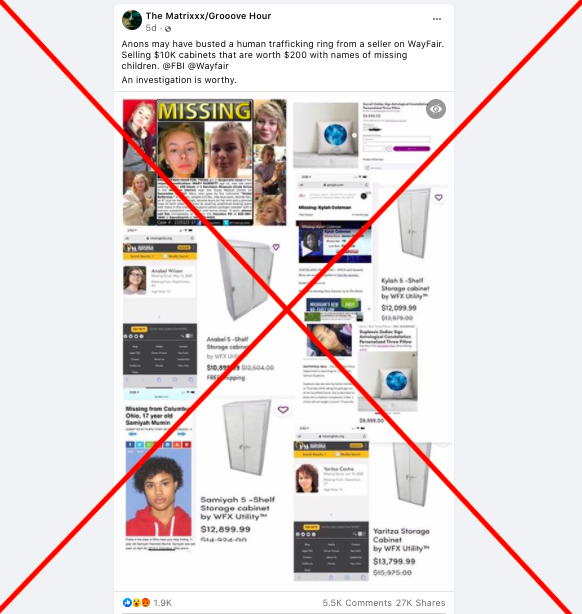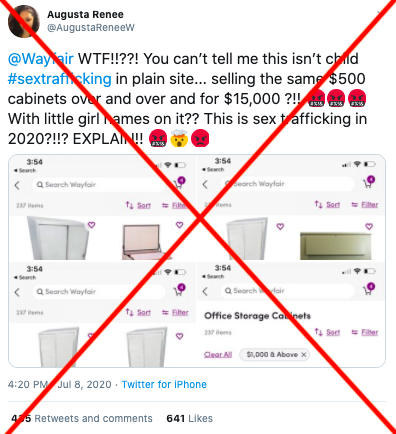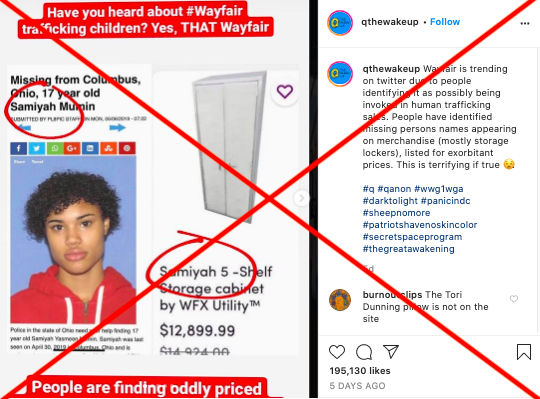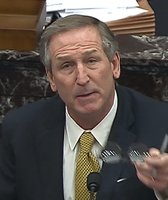Get PolitiFact in your inbox.
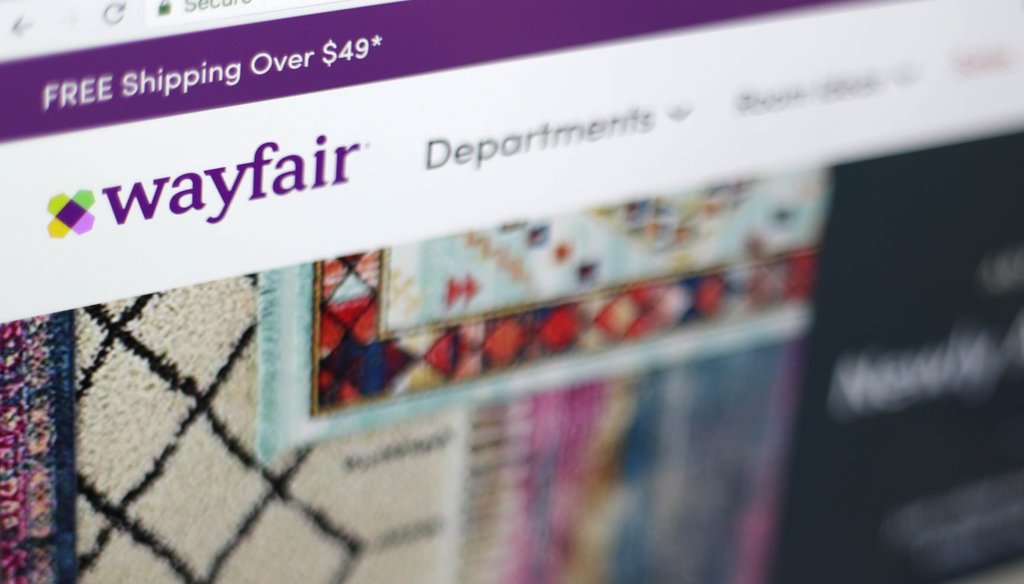
This April 17, 2018, file photo shows the Wayfair website on a computer in New York. (AP)
If Your Time is short
-
Posts linking Wayfair to child sex trafficking have been shared hundreds of thousands of times over the past week. There is no evidence to support them.
-
The conspiracy theory rests on a mix of circumstantial evidence, unrelated observations and a misunderstanding of how Wayfair works. The company has denied being connected to a sex trafficking operation and several missing children reports cited in social media posts have been resolved.
-
The Wayfair conspiracy theory originated on Twitter and Reddit before spreading to other platforms. QAnon and Pizzagate believers played a key role in helping the rumors go viral.
A hoax about an online furniture store and child sex trafficking made its way to social media feeds with the help of groups dedicated to pushing debunked conspiracy theories from the 2016 election.
The viral rumors go like this:
Wayfair.com, a website that sells home goods and furniture, listed several cabinets, pillows and other items for thousands of dollars. Some of those items had names that purportedly matched reports of missing children from around the country, such as Neriah, Samiyah and Yeritza.
Tens of thousands of social media users pieced those observations together with cell phone screenshots, red circles and lots of question marks to accuse Wayfair of selling and shipping children to pedophiles.
"Anons may have busted a human trafficking ring from a seller on WayFair. Selling $10K cabinets that are worth $200 with names of missing children," wrote one Facebook page.
Sign up for PolitiFact texts
"@Wayfair needs to be closely examined by @FBI," one Twitter user said.
"When will the mainstream media talk about WayFair trafficking?" asked an Instagram account dedicated to the conspiracy theory.
Some of the posts, which were shared by a mix of anti-vaccine pages, conspiratorial groups and everyday social media users, were flagged as part of Facebook’s efforts to combat false news and misinformation on its News Feed. (Read more about our partnership with Facebook, which owns Instagram.)
(Screenshot from Facebook)
Posts linking Wayfair to child sex trafficking have been shared hundreds of thousands of times over the past week, according to CrowdTangle, an audience metrics tool. The rumors have been particularly popular on Instagram, where they have amassed more than 1.4 million interactions. Lifestyle influencers have floated the conspiracy theory to their tens of thousands of followers and teenagers on TikTok are making videos about it.
But how did this conspiracy theory take off in the first place — and how do we know it’s wrong? PolitiFact investigated.
The idea started on Twitter and Reddit before spreading to Facebook pages, groups and Instagram accounts. The same communities post about QAnon and Pizzagate, which involve more baseless claims about sex trafficking.
"The panic around widespread and prevalent sex trafficking by certain groups (sometimes the rich and politically powerful, sometimes members of certain religions) has been around for a very long time," said Mark Fenster, a law professor at the University of Florida and a conspiracy theory expert.
Wayfair not involved in sex trafficking
There is no evidence that Wayfair is selling children through its website.
Let’s review some of the evidence that the social media posts in question provide.
No. 1: Some names of pricey items on the company’s website match those of children reported as missing across the country. Could that mean something bigger is going on?
No, it’s a coincidence. Many businesses, such as IKEA, give human names to products. And most of the children cited in social media posts about Wayfair have been found.
For example, social media users have claimed that Yaritza Castro, Samara Duplessis, Cameron Dziedzic, Mary Durrett, Kylah Coleman and Samiyah Mumin are all allegedly missing and connected to Wayfair. Mediawise (another fact-checking organization based at the Poynter Institute) looked into each case and found that one of those children remains missing. There is no evidence that any of them were trafficked by Wayfair.
Other product screenshots get the prices wrong. One Twitter user posted an image of a lumbar pillow from Ellen DeGeneres’ Wayfair collection that the user said sells for more than $10,000. The actual listing says it costs $99.
So why are some of Wayfair’s products, like cabinets, listed for thousands of dollars? (Wayfair is not a luxury goods site.) The answer has to do with Wayfair’s structure as a company, the kinds of products that get listed and how things are priced on the internet.
Wayfair sells more than 14 million products across five websites, Vox reported last year. It does not manufacture any of the products it sells. Instead, each time a customer places an order on its website, Wayfair orders the item from one of its 11,000 suppliers.
Some of those suppliers sell expensive items like industrial-grade cabinets, which retail for thousands of dollars on similar websites, such as Amazon. Fortune magazine reported that items from online retailers sometimes have high price tags because of algorithms or placeholder pricing from third-party suppliers.
That’s not the case with the Wayfair cabinets, though.
The brand name cited in many of the social media posts is "WFX Utility," a trademark that Wayfair owns, according to the United States Patent and Trademark Office. John Costello, a corporate communications manager for Wayfair, said the company temporarily removed listings for WFX Utility cabinets so it could work with its supplier to create better explanations for those products.
"The products in question are industrial grade cabinets that are accurately priced," Costello said. "Recognizing that the photos and descriptions provided by the supplier did not adequately explain the high price point, we temporarily removed the products from (the) site to rename them and provide a more in-depth description and photos that accurately depict the product to clarify the price point."
RELATED: No, this photo doesn’t show Ghislaine Maxwell with a Wayfair executive
Another major component of the Wayfair conspiracy theory claims that the stock-keeping unit (SKU) numbers for the cabinets correspond to images of children on Yandex, a Russian search engine.
However, Newsweek found that entering a series of random numbers yielded the same result. Additionally, "none of the SKU searches return images of a single child, which would seem to run counter to the implication that the Wayfair SKUs secretly provide data regarding the specific child to be purchased," the publication wrote.
Finally, some social media users interpreted Wayfair’s name as a compound of "waif" and "fare" — an allusion to a child sex trafficking operation. But Fortune reported last year that the company’s name has no specific meaning.
"There’s no real origin story with the Wayfair name. They paid a branding firm a bunch of money," the magazine wrote.
Rumors get boost from conspiracy groups
At 4:03 p.m. on July 8, Augusta Renee Wood tweeted four screenshots of storage cabinets.
"@Wayfair WTF is this??!!! You cannot tell me this isn’t child #sextrafficking. The same $500 cabinet posted over and over again with different little girl names for $15,000?!!! Is this how they’re getting the platform to BUY children in 2020??!! EXPLAIN!!" she wrote.
The post appears to be the first time that someone mentioned a connection between Wayfair and child sex trafficking. It got very little engagement, so Wood tweeted again nearly 20 minutes later.
That post was retweeted more than 430 times.
(Screenshot from Twitter)
"I have 100 followers.. I had no idea it would blow up," Wood told PolitiFact in a message. "I’m glad it did..I’m not a conspiracy theorist but you can’t ignore how the internet broke overnight with all this information and by 10 am the next day the file cabinets were gone."
"This just has to be deeper than overly expensive file cabinets."
A Reddit user named PrincessPeach1987 agreed. At 9:04 a.m. on July 9, she posted a thread to /r/conspiracy, a subreddit dedicated to conspiracy theories.
"Is it possible Wayfair involved in Human trafficking with their WFX Utility collection? Or are these just extremely overpriced cabinets?" PrincessPeach1987 wrote.
The thread, which included screenshots of four cabinets listed for more than $12,000 on Wayfair’s website, received more than 5,000 upvotes (Reddit’s version of likes). Several news outlets cited it as the source of the conspiracy theory that would later spread to every major social media platform.
By July 10, posts linking Wayfair to sex trafficking hit a peak on Facebook, where they received more than 100,000 likes, shares and comments, according to CrowdTangle. Google searches for the company peaked the next day, according to Google Trends, as did Instagram posts questioning the trafficking link.
In the two days between Woods’ tweet and the explosion of Facebook posts, groups known to peddle misinformation helped amplify the Wayfair conspiracy theory into the mainstream.
One of the earliest and most popular Facebook posts was published by an anti-vaccine page on the evening of July 9. It included #Wayfair with an image of a child bound with rope, which was shared more than 40,000 times.
Other early mentions were shared in Facebook groups for residents in places like Moreno Valley, Calif., and Branch County, Mich.
The July 10 Facebook post mentioning "anons" was published by a page for believers of QAnon, a right-wing conspiracy theory that in part alleges President Donald Trump and former special counsel Robert Mueller are working together to arrest child molesting elites. Other posts from QAnon pages, which have since been deleted, helped spread the theory to thousands of additional Facebook users.
(Screenshot from Instagram)
But Wayfair rumors found a larger audience on Instagram, where QAnon accounts, anti-vaxxers and influencers with a history of publishing misinformation posted more screenshots of Wayfair cabinets juxtaposed with missing children reports. Since July 9, those posts have received more than 1.4 million interactions, according to CrowdTangle.
QAnon has been steadily gaining followers in the lead-up to the presidential election — and it’s rooted in one of the most notorious incidents from the 2016 campaign, Pizzagate.
Wayfair conspiracy theory borne of 2016 hoax
To some experts, it wasn’t surprising to see the Wayfair rumors take off on social media. Allegations about child sex trafficking have been amplified before by followers of QAnon, and Pizzagate before that.
The main message of QAnon, which takes its name from a 4chan user named "Q" — a reference to a security clearance needed for high-level government information — is unclear. But many followers believe in "The Storm," which is when they claim Trump and Mueller will start arresting former presidents and other members of the "Deep state" for their involvement in pedophile rings, among other offenses.
The Pizzagate conspiracy theory emerged during the 2016 campaign after WikiLeaks released emails from John Podesta, Hillary Clinton’s campaign manager. Some fringe internet users noticed that Podesta had communicated with the owner of Comet Ping Pong pizzeria in Washington, D.C., to discuss a potential fundraiser. They claimed that Podesta’s use of the word "pizza" was a code word for pedophilia and that Comet Ping Pong was holding children hostage for Clinton and her allies to abuse.
RELATED: How Pizzagate went from fake news to a real problem for a D.C. business
In December 2016, a North Carolina man entered the pizzeria with an assault rifle to "self-investigate" the claims. The man fired his rifle inside the restaurant before he surrendered, with no reported injuries.
"Pizzagate predated QAnon, and the latter adapted Pizzagate’s obsession with the Clintons’ (and their circle’s) alleged evil, which included (among other things) sexual predation," said Fenster of UF. "Pizzagate originated in decentralized online forums, something else QAnon has continued and which have become the most important way by which such theories circulate."
Several versions of the Wayfair conspiracy theory bubbled up in groups dedicated to Pizzagate and QAnon. And over the past few months, sex trafficking conspiracy theories have continued to gain traction and accrue followers online — particularly among young people on TikTok and Instagram.
The reason why is a mix of fears about the abuse of children and the perception of online retailers as greedy, according to Fenster.
"That, coupled with both the deep partisan politicization of everything these days and the ability to allege and circulate rumors online, make these kinds of claims appear at least superficially credible and make them easier to distribute and gain attention," he said.
Our Sources
BuzzFeed News, "The Conspiracy Theory About Wayfair Is Spreading Fast Among Lifestyle Influencers On Instagram," July 13, 2020
BuzzFeed News, "Lifestyle Influencers Are Now Sharing Some Bogus Far-Right Conspiracy Theories About The Coronavirus On Instagram," April 4, 2020
CrowdTangle, accessed July 13, 2020
Email from John Costello, corporate communications manager for Wayfair, July 13, 2020
Facebook post, July 9, 2020
Facebook post, July 9, 2020
Facebook post, July 9, 2020
Facebook post, July 9, 2020
Facebook post, July 10, 2020
Facebook post, July 10, 2020
Facebook post, July 10, 2020
Facebook post, July 11, 2020
Facebook post, July 12, 2020
Facebook post, July 14, 2020
Fortune magazine, "It’s All Clicking for Wayfair, a Fortune 500 Newcomer," May 16, 2019
Fortune magazine, "What causes crazy-high prices on Wayfair and Amazon?" July 14, 2020
Fox Business, "Ellen questioned for Wayfair partnership amid conspiracy theory," July 13, 2020
Google Trends, accessed July 13, 2020
Heavy, "Wayfair Conspiracy Theory Trending on Social Media Explained," July 12, 2020
Insider, "How the Wayfair human-trafficking conspiracy theory grew out of QAnon," July 13, 2020
Instagram post, July 9, 2020
Instagram post, July 10, 2020
Instagram post, July 11, 2020
Instagram post, July 13, 2020
Media Matters for America, "Here are the QAnon supporters running for Congress in 2020," July 13, 2020
Newsweek, "Kids Shipped in Armoires? The Person Who Started the Wayfair Conspiracy Speaks," July 10, 2020
The New York Times, "‘PizzaGate’ Conspiracy Theory Thrives Anew in the TikTok Era," June 27, 2020
PolitiFact, "How Pizzagate went from fake news to a real problem for a D.C. business," Dec. 5, 2016
PolitiFact, "QAnon and Donald Trump rallies: What's that about?" Aug. 3, 2018
PolitiFact, "There’s no evidence that the Clintons were involved in Jeffrey Epstein’s death," Aug. 12, 2019
Quartz, "The secret taxonomy behind IKEA’s product names, from Billy to Poäng," Jan. 30, 2017
Reddit thread, July 9, 2020
Reuters, "Fact check: No evidence linking Wayfair to human trafficking operation," July 13, 2020
Snopes, "Is Wayfair Trafficking Children Via Overpriced Items?" July 10, 2020
TikTok video, July 11, 2020
Tweet, July 9, 2020
Tweet, July 10, 2020
Tweet from MediaWise, July 13, 2020
Tweet from NBC News reporter Ben Collins, July 10, 2020
U.S. Patent and Trademark Office, "WFX Utility," accessed July 14, 2020
Vox.com, "Wayfair, the internet’s massive online furniture store, explained," Aug. 28, 2019
YouTube video from BuzzFeed News, June 12, 2019

